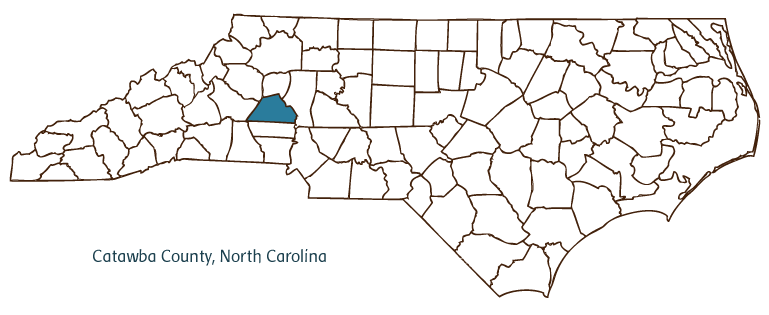Catawba County Resources
- View All:
- Biographies
- Monuments
- locations
Technicians will be working on our network from 5 a.m. to 11 a.m. on Saturday, Dec. 13th. We apologize in advance for any downtime you may experience during this time.
Copyright Notice: This article is from the Encyclopedia of North Carolina edited by William S. Powell. Copyright © 2006 by the University of North Carolina Press. Used by permission of the publisher. For personal use and not for further distribution. Please submit permission requests for other use directly to the publisher.

Catawba County, located in the western Piedmont region of North Carolina in the foothills of the Blue Ridge Mountains, was formed in 1842 from Lincoln County. The county was named for the Catawba Indians, who once inhabited the land. After the Catawba, other early inhabitants included German, Swiss, and Scotch-Irish settlers. The county seat is Newton, incorporated in 1855 and named for Isaac Newton Wilson, a member of the North Carolina General Assembly who first proposed formation of the county in the legislature. Other communities in the county include Hickory, Maiden, Brookford, Claremont, and Longview. Physical features influencing the culture and character of Catawba County include the Catawba River, Lake Hickory, Lookout Shoals Lake, Mountain Creek, and Anderson Mountain. Lake Norman, a massive reservoir, is a popular destination for recreational boaters, swimmers, and fishers.
Catawba County-in particular Hickory-has been an important furniture manufacturing region for decades. Other manufactures include textiles, gloves, cables, and telecommunications equipment. County agricultural products include corn, soybeans, barley, livestock feed, swine, poultry, and both beef and dairy cattle. Catawba County was part of the short but lucrative North Carolina gold rush of the mid-1800s.
Catawba County has a host of historic landmarks, including the Hickory Motor Speedway; Bunker Hill Covered Bridge (1895); Maple Grove (ca. 1875), an Italianate-style home in Hickory; and Shuford Memorial Gardens. Catawba College was founded in Newton in 1851, and 40 years later Lenoir-Rhyne College was established in Hickory. Cultural institutions include the Maiden Public Library, the Catawba County Council for the Arts, the Western Piedmont Symphony, and the Green Room Community Theatre. The Hickory Museum of Art is North Carolina's second-oldest museum, boasting one of the finest collections of American art in the Southeast. Catawba County's popular annual events include Octoberfest, the Old Soldiers Reunion Celebration, Big Sunday at Balls Creek Camp Grounds, and the Strawberry Festival and Craft Show. Catawba County's population was estimated to be 148,000 in 2004.
For an annotated history of the county's formation, with the laws affecting the county, boundary lines and changes, and other origin information, visit these references in The Formation of the North Carolina Counties (Corbitt, 2000), available online at North Carolina Digital Collections (note, there may be additional items of interest for the county not listed here):
County formation history: https://digital.ncdcr.gov/Documents/Detail/the-formation-of-the-north-ca...
Index entry for the county: https://digital.ncdcr.gov/Documents/Detail/the-formation-of-the-north-ca...
Correction to this entry: Newton, county seat of Catawba County, was named for Isaac Newton Wilson, son of Nathaniel Wilson. It was Nathaniel Wilson who was a representative in the North Carolina General Assembly three times, in 1842, 1844, and 1846. While in the General Assembly, Nathaniel Wilson introduced the bill to create Catawba County. Newton was incorporated in 1855.
-- Kelly Agan, NC Goverment & Heritage Library, 2017
References:
Gary R. Freeze, The Catawbans: Crafters of a North Carolina County (1995).
Sidney Halma, Catawba County: An Architectural History (1991).
Additional resources:
Corbitt, David Leroy. 2000. The formation of the North Carolina counties, 1663-1943. https://digital.ncdcr.gov/Documents/Detail/the-formation-of-the-north-carolina-counties-1663-1943/3692099?item=4553233 (accessed June 20, 2017).
Catawba County Government: http://www.catawbacountync.gov/
Catawba County Library: https://www.catawbacountync.gov/county-services/library/
Catawba County Chamber of Commerce: https://catawbachamber.org/
DigitalNC, Catawba County: https://www.digitalnc.org/counties/catawba-county/
Hickory Public Library: http://www.hickorync.gov/library/
North Carolina Digital Collections (explore by place, time period, format): https://digital.ncdcr.gov
Image credits:
Rudersdorf, Amy. 2010. "NC County Maps." Government & Heritage Library, State Library of North Carolina.
Bayley, Elizabeth. "Catawba County." NCpedia. State Library of NC. 2006. https://www.ncpedia.org/geography/catawba.